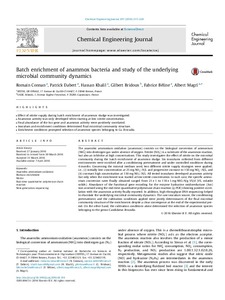Mostra el registre d'ítem simple
Batch enrichment of anammox bacteria and study of the underlying microbial community dynamics
| dc.contributor.author | Connan, Romain |
| dc.contributor.author | Dabert, Patrick |
| dc.contributor.author | Khalil, Hassan |
| dc.contributor.author | Bridoux, Gilbert |
| dc.contributor.author | Béline, Fabrice |
| dc.contributor.author | Magrí Aloy, Albert |
| dc.contributor.other | Universitat Politècnica de Catalunya. Departament d'Enginyeria Agroalimentària i Biotecnologia |
| dc.date.accessioned | 2017-06-26T09:14:22Z |
| dc.date.available | 2019-05-01T00:31:06Z |
| dc.date.issued | 2016 |
| dc.identifier.citation | Connan, R., Dabert, P., Khalil, H., Bridoux, G., Béline, F., Magrí, A. Batch enrichment of anammox bacteria and study of the underlying microbial community dynamics. "Chemical engineering journal", 2016, vol. 297, p. 217-228. |
| dc.identifier.issn | 1385-8947 |
| dc.identifier.uri | http://hdl.handle.net/2117/105852 |
| dc.description.abstract | The anaerobic ammonium oxidation (anammox) consists on the biological conversion of ammonium (NH4+) into dinitrogen gas under absence of oxygen. Nitrite (NO2-) is a substrate of the anammox reaction, but also an inhibitor at high concentrations. This study investigates the effect of nitrite on the microbial community during the batch enrichment of anammox sludge. Six inoculums collected from different environments were enriched after a conditioning pretreatment and under controlled conditions during 4 months. Concerning the mineral medium used, two different nitrite supply strategies were applied; i.e., (i) initially low concentration at 25 mg NO2-–N/L and progressive increase to 150 mg NO2-–N/L, and (ii) constant high concentration at 150 mg NO2-–N/L. All tested inoculums developed anammox activity but only when the enrichment was started at low nitrite concentration. In such case, the specific ammonium conversion rates finally obtained ranged from 21 ±1 to 118 ±1 mg NH4+–N/g VS/d (VS, volatile solids). Abundance of the functional gene encoding for the enzyme hydrazine oxidoreductase (hzo) was assessed using the real-time quantitative polymerase chain reaction (q-PCR) showing positive correlation with the anammox activity finally reported. In addition, high-throughput DNA sequencing helped to elucidate the underlying microbial community dynamics. The raw inoculum source, the conditioning pretreatment, and the cultivation conditions applied were jointly determinants of the final microbial community structure of the enrichments despite a clear convergence at the end of the experimental period. On the other hand, the cultivation conditions alone determined the selection of anammox species belonging to the genus Candidatus Brocadia. |
| dc.format.extent | 12 p. |
| dc.language.iso | eng |
| dc.rights | Attribution-NonCommercial-NoDerivs 3.0 Spain |
| dc.rights.uri | http://creativecommons.org/licenses/by-nc-nd/3.0/es/ |
| dc.subject | Àrees temàtiques de la UPC::Enginyeria agroalimentària |
| dc.subject.lcsh | Nitrification |
| dc.subject.other | anaerobic ammonium oxidation |
| dc.subject.other | biomass enrichment |
| dc.subject.other | nitrite |
| dc.subject.other | real-time quantitative polymerase chain reaction |
| dc.subject.other | next-generation sequencing |
| dc.title | Batch enrichment of anammox bacteria and study of the underlying microbial community dynamics |
| dc.type | Article |
| dc.subject.lemac | Compostatge |
| dc.identifier.doi | 10.1016/j.cej.2016.03.154 |
| dc.relation.publisherversion | http://www.sciencedirect.com/science/article/pii/S1385894716304296 |
| dc.rights.access | Open Access |
| local.identifier.drac | 19103528 |
| dc.description.version | Postprint (updated version) |
| local.citation.author | Connan, R.; Dabert, P.; Khalil, H.; Bridoux, G.; Béline, F.; Magrí, A. |
| local.citation.publicationName | Chemical engineering journal |
| local.citation.volume | 297 |
| local.citation.startingPage | 217 |
| local.citation.endingPage | 228 |
Fitxers d'aquest items
Aquest ítem apareix a les col·leccions següents
-
Articles de revista [1.059]



